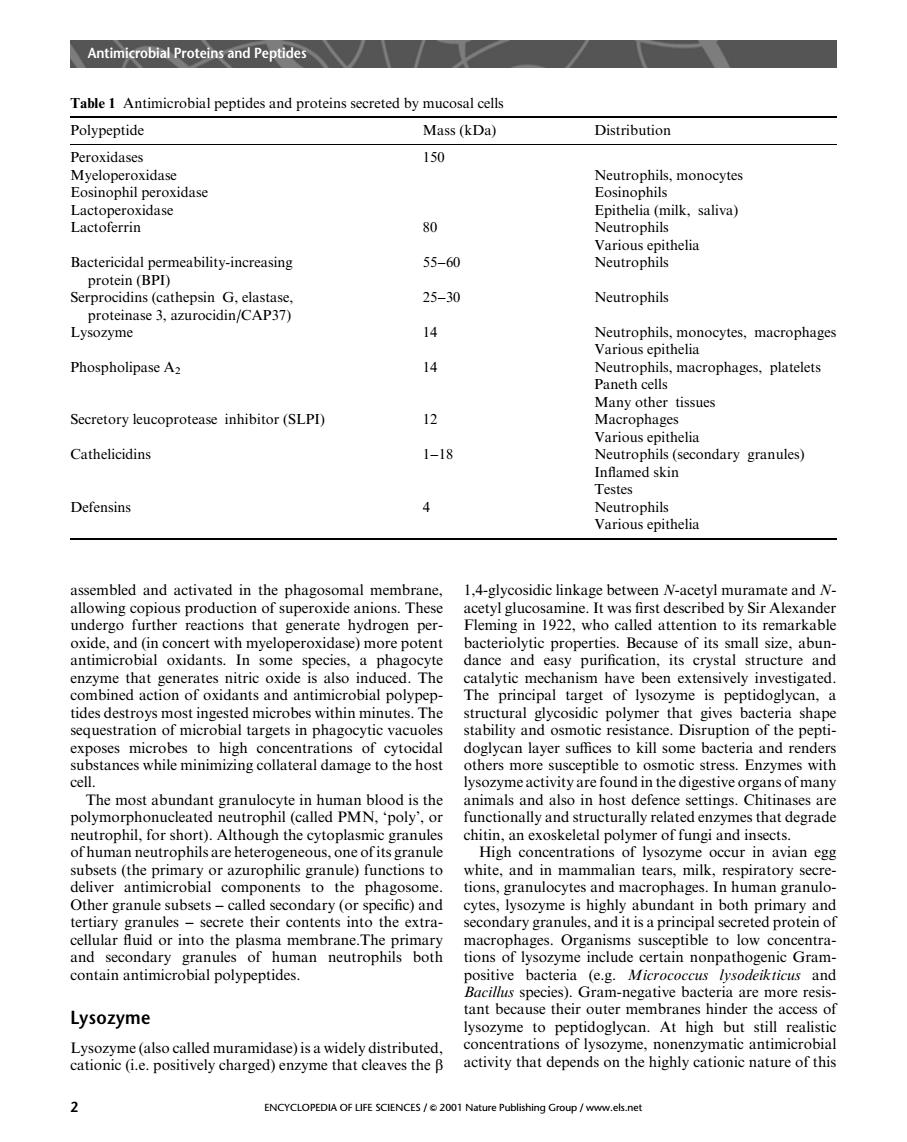正在加载图片...

Antimicrobial Proteins and Peptides Table 1 Antimicrobial peptides and proteins secreted by Polypeptide Mass (kDa) Distribution Peroxidases 150 Myeloperoxidase Neutrophils,monocytes hi 80 Various epithelia Bactericidal permeability-increasing 55-60 Neutrophils protein (BP1) 25-30 Neutrophils 14 Neutrophils,monocytes,macrophages Varous epithelia 14 Many other tissues Secretory leucoprotease inhibitor(SLPI) 12 Macrophages Various epithelia Cathelicidins 1-18 Defensins Neutrophils Various epithelia omal mem 1.4-glycosidic linkage between Smate and undergo further reactions that g atehydrogen oxide,and (in concert with myeloperoxidase)more potent bacteriolytic properties.Because of its small size,abun antimicrobial oxidants. nsome species, a phagocyte and easy purification,its crystal structure and enzym e is also The me have been extensively tides destr ed microbes within minutes The sequestration of microbial targets in phagocytic vacuoles nd omoiseiance.Disruption of the peti ons of cytocidal doglycan layer suffices to kill some bacteria and rend stress.Enzym wit The most abundant granulocyte in human blood is the nimals and also in host defence settings.Chitinases ar polymorphonucleated neutrophil (called PMN,poly',or functionally and structurally related enzymes that degrade chitin,an exoskelet al polymer of fungi and insects eous,one igh avian egg deliver antimicrobial components to the p tions.granuloevtes and macrophas s.in human granulo Other granule subsets-called secondary (or spec fic)and cytes,lysozyme is highly abundant in both primary and rete their contents inte the extra secondary granules,and it is a principal secr eted protein of or into the pl a membrane.Th nacropha ges polypeptides man neutrophi sitive b and Bacils species).Gram-negative bacteria are more resis Lysozyme tant because their outer membrane access o ysozyme to At still rea activity that depends on the highly cationic nature of this ENCYCLOPEDIA OF LIFE SCIENCES/e 2001 Nature Publishing Group /www.els.net assembled and activated in the phagosomal membrane, allowing copious production of superoxide anions. These undergo further reactions that generate hydrogen peroxide, and (in concert with myeloperoxidase) more potent antimicrobial oxidants. In some species, a phagocyte enzyme that generates nitric oxide is also induced. The combined action of oxidants and antimicrobial polypeptides destroys most ingested microbes within minutes. The sequestration of microbial targets in phagocytic vacuoles exposes microbes to high concentrations of cytocidal substances while minimizing collateral damage to the host cell. The most abundant granulocyte in human blood is the polymorphonucleated neutrophil (called PMN, ‘poly’, or neutrophil, for short). Although the cytoplasmic granules of human neutrophils are heterogeneous, one of its granule subsets (the primary or azurophilic granule) functions to deliver antimicrobial components to the phagosome. Other granule subsets – called secondary (or specific) and tertiary granules – secrete their contents into the extracellular fluid or into the plasma membrane.The primary and secondary granules of human neutrophils both contain antimicrobial polypeptides. Lysozyme Lysozyme (also called muramidase) is a widely distributed, cationic (i.e. positively charged) enzyme that cleaves the b 1,4-glycosidic linkage between N-acetyl muramate and Nacetyl glucosamine. It was first described by Sir Alexander Fleming in 1922, who called attention to its remarkable bacteriolytic properties. Because of its small size, abundance and easy purification, its crystal structure and catalytic mechanism have been extensively investigated. The principal target of lysozyme is peptidoglycan, a structural glycosidic polymer that gives bacteria shape stability and osmotic resistance. Disruption of the peptidoglycan layer suffices to kill some bacteria and renders others more susceptible to osmotic stress. Enzymes with lysozyme activity are found in the digestive organs of many animals and also in host defence settings. Chitinases are functionally and structurally related enzymes that degrade chitin, an exoskeletal polymer of fungi and insects. High concentrations of lysozyme occur in avian egg white, and in mammalian tears, milk, respiratory secretions, granulocytes and macrophages. In human granulocytes, lysozyme is highly abundant in both primary and secondary granules, and it is a principal secreted protein of macrophages. Organisms susceptible to low concentrations of lysozyme include certain nonpathogenic Grampositive bacteria (e.g. Micrococcus lysodeikticus and Bacillus species). Gram-negative bacteria are more resistant because their outer membranes hinder the access of lysozyme to peptidoglycan. At high but still realistic concentrations of lysozyme, nonenzymatic antimicrobial activity that depends on the highly cationic nature of this Table 1 Antimicrobial peptides and proteins secreted by mucosal cells Polypeptide Mass (kDa) Distribution Peroxidases 150 Myeloperoxidase Neutrophils, monocytes Eosinophil peroxidase Eosinophils Lactoperoxidase Epithelia (milk, saliva) Lactoferrin 80 Neutrophils Various epithelia Bactericidal permeability-increasing protein (BPI) 55–60 Neutrophils Serprocidins (cathepsin G, elastase, proteinase 3, azurocidin/CAP37) 25–30 Neutrophils Lysozyme 14 Neutrophils, monocytes, macrophages Various epithelia Phospholipase A2 14 Neutrophils, macrophages, platelets Paneth cells Many other tissues Secretory leucoprotease inhibitor (SLPI) 12 Macrophages Various epithelia Cathelicidins 1–18 Neutrophils (secondary granules) Inflamed skin Testes Defensins 4 Neutrophils Various epithelia Antimicrobial Proteins and Peptides 2 ENCYCLOPEDIA OF LIFE SCIENCES / & 2001 Nature Publishing Group / www.els.net